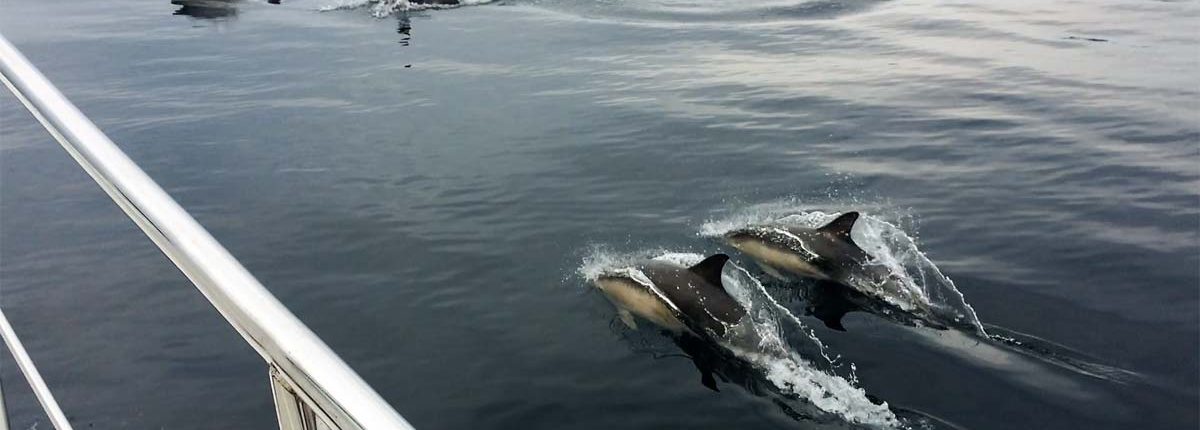Marine-life & wildlife
The seas around the Northwest Highlands and Islands are teeming with life, and our cruises frequently bring us as close to the local sea-life as you can hope for. The abundance of fish attracts all kinds of animals to the area. The seas around the area begin to fill with a variety of fish in the spring, too numerous to list here, but perhaps the most important are mackerel, sand eels, and sprats, which appear to throng the bays on warm summer evenings.
Indeed, we begin to see large Bottle-nosed Dolphins in the waters around the Small Isles beginning in April, but as we move into May and the start of the summer season, Common Dolphins visit the area, seeming to delight in coursing and skipping alongside the local boats. The Porpoise, on the other hand, is much more timid and shy, but it spends the entire year around the islands, and large pods of them can be seen roaming from time to time further out into the deeper waters. It is not uncommon to see Minke Whales around the islands during this time of year; in particular, they can be found feeding in the waters off Muck, thought to be drawn there by a combination of the tides around Ardnamurchan and the abundance of food in that area. During the hot summer months, another deep-sea colossus arrives in the area: basking sharks. Despite the fact that these creatures are gentle and harmless filter-feeders, their sheer size can be frightening at first!
We’ve recently seen much larger species of jellyfish floating into the area. Aside from the little purple-ringed moon jellyfish, there are also the compass jellyfish, the ethereal-looking dustbin jellyfish, and the lion’s mane jellyfish, which is the world’s third-longest recorded animal! Similarly, on recent trips, we have seen the white-tailed sea eagle, which was reintroduced into the wild around 25 years ago from the island of Rum, after becoming extinct in Scotland in the early 1920s. Sightings of creatures such as the strange-looking Sunfish, Killer Whales, and Humpback Whales are much more rare.
Book one of our adventures for the chance to experience the local wildlife for yourself!
Coastal-life
As one might expect, the area’s coastal beaches and cliffs are home to a diverse range of wildlife. A look into any barnacle-encrusted rockpool on any shore should give you an impression of this variety; this is a look into a floating, transparent world of fluted shells and shards of coral, blue mussels, mermaids’ purses, violet-spined sea urchins, squashy and bright red sea anemones, green shore crabs and velvet swimming crabs, hermit crabs, winkles and dog whelks, armoured limpets, darting shrimp and the Great British blennies.
In these waters around our coastline we have made a habit of laying down creels to catch edible crabs and lobsters, which ordinarily would not scuttle too close to land. This variety of fish and shellfish is obviously why so many animals choose to cluster around the coastlines, such as families of otters and the common and grey seals that are regularly to be seen on the shores around Loch Nevis. Some seals, though, would seem to prefer for themselves an easier lifestyle and enjoy being hand-fed from the pontoon in the harbour!
The area’s coastlines also accommodate a great deal of bird life. Come late July and into August, these communities flourish around the islands and Loch Nevis, where you can see gannets diving on shoals of mackerel. Colonies of puffins can be found nesting on the grassy cliffs of Muck and Canna, Across the water, on Rum, there is, come July, the largest rafting of manx shearwaters to be found in the UK. Down on the shorelines you can find cormorants and shags perched on the rocks like question marks and, Eider ducks paddling in the tidal shallows.
Mountain/Loch-life
Drawing back from the sea and the shorelines, the hills and lochs still boast their own wildlife. The area is home to many iconic woodland and highland animals and birds, such as the red deer bounding across the hills. Walking alongside the Lochs and their estuaries you can sometimes spot otters scampering in and out of the water. Apart from the various species of waterfowl to be seen paddling and wading there, grey herons commonly make their nests along these waters. Weasels, stoats, and badgers like to keep out of sight, but sometimes pop up and you might get to spy Pine Martens clambering up trees to hide and shelter from the area’s several species of raptor, such as sparrowhawks, buzzards, kestrels, barn owls and, perhaps most magnificent of all, the golden eagle.
Rum’s national park has some things to see that are peculiar to that island alone. For example, on the slopes of Rum’s hillsides you can find wild goats leaping from stone to stone and a population of wild ponies that have been on the island for some one thousand years! Indeed, Rum’s famous population of red deer has been on the island so long that they are protected by law. The island’s woods, much like those of the mainland, murmur with small woodland birds, but the hill-lochs of the island play home to some rare varieties of waterfowl like red-throated divers; lochs, it might be added, whose peat stained waters abound with magnificent wild brown trout.
Book one of our adventures for the chance to experience the local wildlife for yourself!





